York Minster, built mainly between 1220 and 1480, is one of the largest medieval cathedrals in Northern Europe and among the most beautiful Gothic buildings in the world. While it is a real highlight of a visit to York, the city has a number of other attractions, including the superb National Railway Museum, the largest railway museum in the world with over 100 locomotives on display, and the York City Walls that date from the 13th century and are the most complete medieval city walls in England.
Jennifer loved visiting York Minster as a child and climbing up to the top of the tower for it’s excellent views, and was excited to revisit. From Liverpool, we made a two-night visit by train to York, stopping en route in Huddersfield to visit relatives. We had an excellent time exploring the city and York Minster, and Jennifer found the climb to the tower just as much fun as she remembered.
Below are trip highlights from November 7th and 8th in York, UK. Click any image for a larger view, or click the position to view the location on a map. And a live map of our current route and most recent log entries always is available at http://mvdirona.com/maps
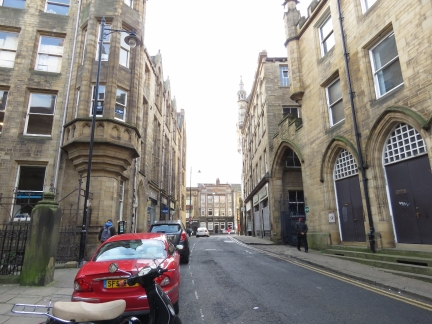 |
Huddersfield
Position: -1 47.01, 53 38.86
Looking down Station Street in Huddersfield, where we’d stopped en route between Liverpool and York. Huddersfield is the 11th largest city in Britain and was a prominent textile center during the Industrial Revolution. The town is known for its beautiful Victorian buildings, built at the peak of its economic prosperity, and for being the birthplace of rugby league.
|
 |
Betty & Dennis Carney
Position: -1 46.91, 53 38.82
The reason we’d stopped off in Huddersfield was to meet Jennifer’s aunt and uncle, Betty and Dennis Carney, who live in nearby Yorkshire. We’ve not seen them since they visited us in Seattle years ago—it was great to catch up.
|
 |
York Station
Position: -1 5.64, 53 57.49
When the current York station opened in 1877 with 13 platforms, it was the largest railway station in the world.
|
 |
The Duke of York
Position: -1 5.57, 53 57.49
We stopped off for a quick lunch at the Duke of York pub at York station.
|
 |
National Railway Museum
Position: -1 5.77, 53 57.62
We spent the rest of the afternoon at the superb National Railway Museum in York. It is the largest railway museum in the world with over 100 locomotives on display. This is overlooking the Great Hall, where most of the locomotives are housed around a working turntable.
|
 |
Mallard
Position: -1 5.77, 53 57.62
Inside the cab of the the Mallard, one of the featured locomotives at the York National Railway Museum. In 1938, the Mallard set the world steam locomotive speed record at 126mph (203 kph), a record that still stands.
|
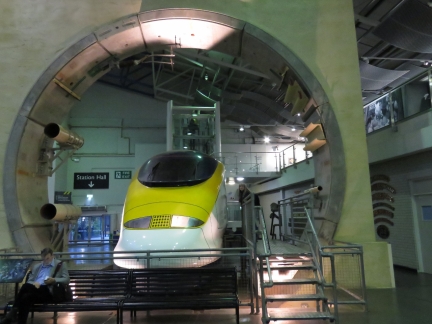 |
Chunnel
Position: -1 5.76, 53 57.62
A replica of the Chunnel (Channel Tunnel between England and France) at the York National Railway Museum.
|
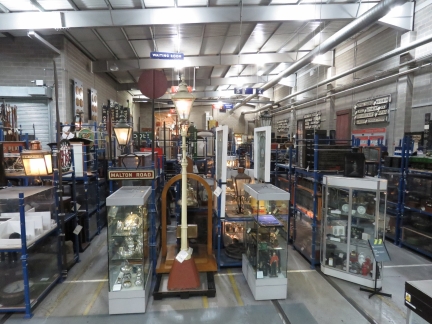 |
Archives
Position: -1 5.75, 53 57.65
The National Collection at the York National Railway Museum includes over 2 million objects, with shelves and shelves of railway memorabilia in its archives area.
|
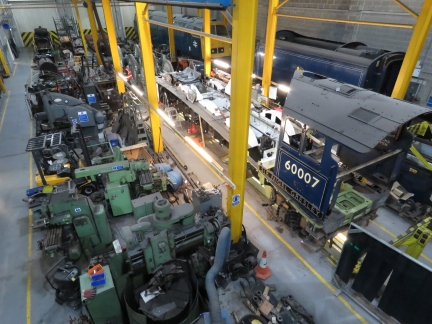 |
The Works
Position: -1 5.71, 53 57.61
Looking down into The Works where workers maintain the York National Railway’s collection of locomotives and carriages, often making parts from scratch. In the foreground is the 1937 steam locomotive Sir Nigel Gresley, whose namesake designed some of the most famous British steam engines, including the Flying Scotsman.
|
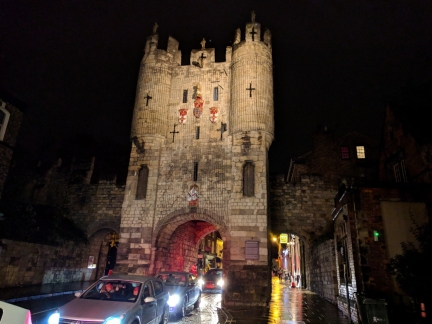 |
Micklegate Bar
Position: -1 5.46, 53 57.34
13th-century York was a walled city and much of that original wall still survives. On our way to dinner we’ll pass through Micklegate Bar, one of several gatehouses along the wall (“bar” is an ancient term for gatehouse).
|
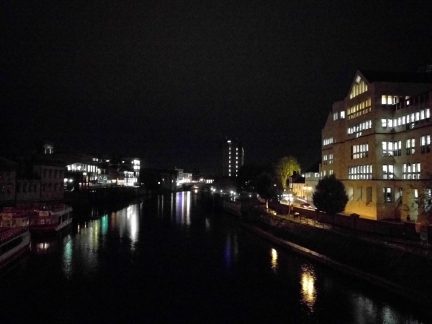 |
River Ouse
Position: -1 5.23, 53 57.60
Looking south along the River Ouse from the Station Road bridge in York. The Romans founded York in AD 71—the site being ideal for a fortress because the river provided access to the North Sea. Today you can take a sightseeing tour boat along the river, a pastime popular since 1840.
|
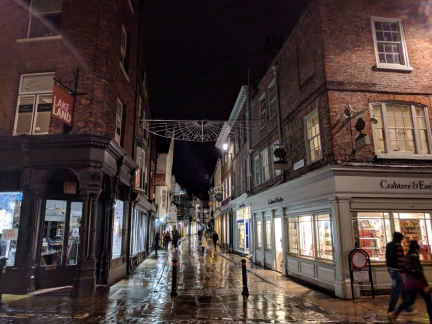 |
Stonegate
Position: -1 5.05, 53 57.62
York has a beautiful downtown, with modern shops and restaurants opening from narrow cobblestone streets. The is the night lights reflecting in wet cobblestone on Stonegate.
|
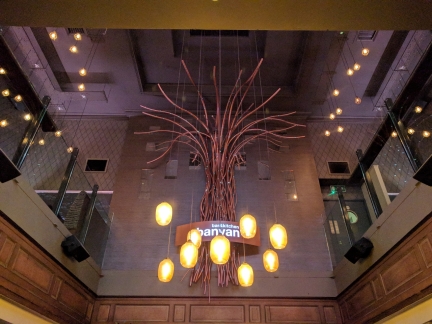 |
Banyan
Position: -1 4.99, 53 57.63
We had a good meal at Banyan Bar and Kitchen on Little Stonegate in downtown York.
|
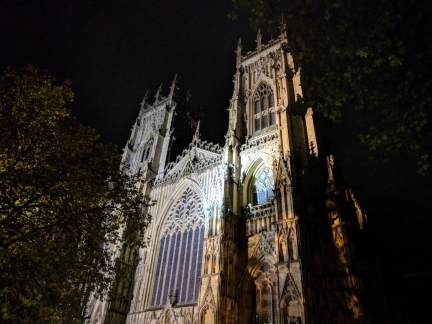 |
York Minster
Position: -1 5.02, 53 57.72
We could hear the bells pealing at York Minster, so walked over to have a look. We’ll be visiting the famous cathedral tomorrow.
|
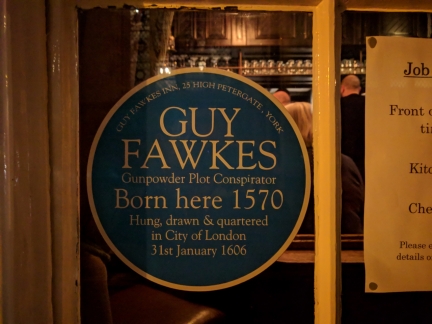 |
Guy Fawkes
Position: -1 4.99, 53 57.71
Guy Fawkes, who plotted to blow up the English Parliament in 1606, was born in York in 1570. The Guy Fawkes Inn stands on the spot where he was born.
|
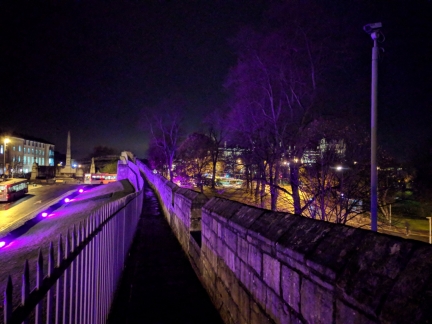 |
City Wall
Position: -1 5.32, 53 57.56
Most of the York City Wall is closed at night for safety reasons, but a portion west of the River Ouse was still open when we returned from dinner. We plan to walk the full wall tomorrow.
|
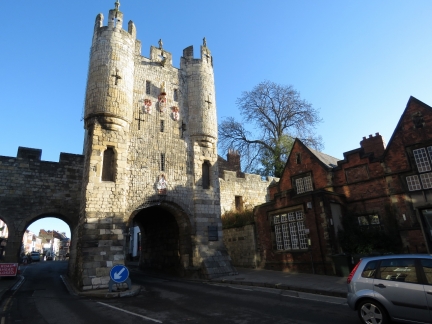 |
Micklegate Bar
Position: -1 5.46, 53 57.35
Micklegate Bar is one of four main gates through the York City Wall, and the most important. Several monarchs have passed through the gate, stopping by tradition to ask the Lord Mayor’s permission to enter the city. The lower section was built in the 12th century and the upper in the 14th. The severed heads of executed rebels and traitors were displayed here for many centuries—the last was removed in 1754.
|
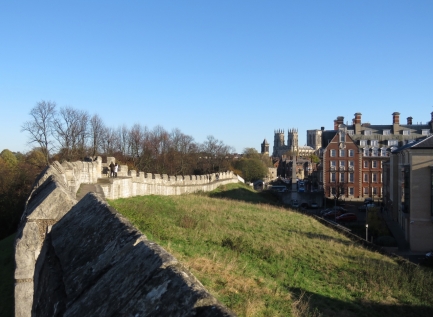 |
City Wall
Position: -1 5.49, 53 57.47
The York City Walls date from the 13th century and are the most complete medieval city walls in England. By the late 18th century, most English cities had demolished their walls because they were no longer needed for defense and the walls obstructed traffic and hindered expansion. The Corporation of York almost did the same, but met with intense local opposition and instead preserved and restored them. This is looking northeast along the wall a short distance west of Micklegate Bar with York Minster visible as the leftmost building in the distance.
|
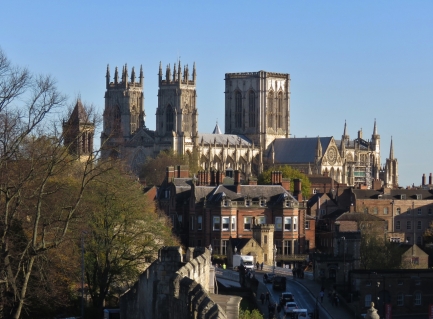 |
York Minster
Position: -1 5.47, 53 57.50
The 235 ft (72 m) central tower 196 ft (60 m) western towers of York Minster stand high above the rest of the city. A church was built on this site as early as 627. Several successive structures were destroyed or damaged and the present minster, one of the largest medieval cathedrals in Northern Europe, was built mainly between 1220 and 1480.
|
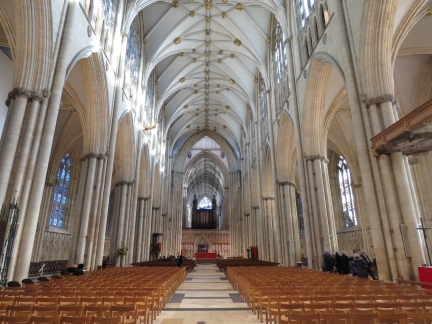 |
Nave
Position: -1 4.99, 53 57.74
York Minster is among the most beautiful Gothic buildings in the world. The magnificent nave pictured here was built in the late 13th century and is roofed in wood painted to look like stone, allowing for a higher and wider area than stone construction. The ceiling soars 99 ft (30m) above the floor.
|
 |
West Window
Position: -1 4.99, 53 57.74
The Great West Window, installed in 1338, is the most impressive of York Minster’s many beautiful medieval stained glass window. It is known as the “Heart of Yorkshire” because of the heart-shaped stone tracery in the upper stonework.
|
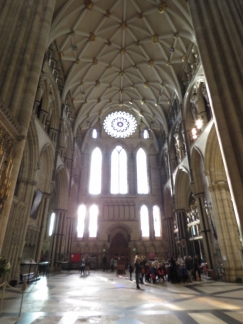 |
Rose Window
Position: -1 4.97, 53 57.74
7,000 pieces of glass make up the circular Rose Window high in the gable of the South Transept. The window commemorates the union of the royal houses of York and Lancaster, who battled for control of the throne during the fifteenth-century in a conflict known as the “War of the Roses”.
|
 |
Five Sisters
Position: -1 4.92, 53 57.74
The Five Sisters dates from the 13th century and is the oldest complete window in York Minster.
|
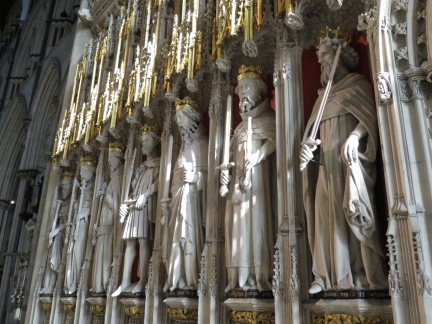 |
King’s Screen
Position: -1 4.91, 53 57.74
The 15th-century King’s Screen is one of the most well-known parts of York Minster. The screen separates the nave from the choir and includes statues of English kings ranging from William the Conqueror to Henry VI.
|
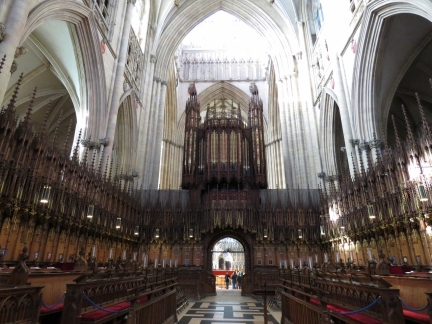 |
Choir
Position: -1 4.91, 53 57.74
Looking west through the intricately-carved wooden choir stalls. The detail in the carvings is amazing.
|
 |
Chapter House
Position: -1 4.89, 53 57.75
The octagonal Chapter House in York Minster was built in the 13th century. Unlike similar structures of its time, the vaulted ceiling has no central support column and is instead supported by an innovative external roof structure.
|
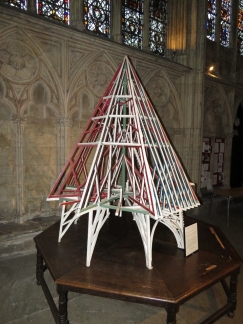 |
Support
Position: -1 4.89, 53 57.75
This model of the Chapter House roof shows the complex timber structure, nearly twice the height of the structure, from which the vaulted ceiling is suspended.
|
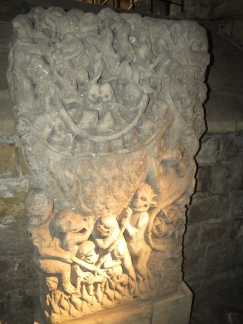 |
Doomstone
Position: -1 4.90, 53 57.75
York Minster was built on the site of an earlier Norman Minster from which this 12-century doomstone was recovered. The stone depicts “Hell’s Cauldron” with devils and demons pushing lost souls into a boiling cauldron.
|
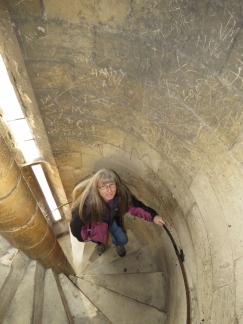 |
Steps
Position: -1 4.96, 53 57.71
Jennifer visited York Minster several times during childhood trips to England from Canada and was eager to return. She particularly remembered climbing the 275-step circular staircase to the top of the central tower and was delighted to learn this was still open to the public.
|
 |
Nave Roof
Position: -1 4.93, 53 57.72
The staircase to the central tower crosses an outdoor balcony with a close-up views to the nave roof and its supporting structure, and the west towers beyond.
|
 |
Central Tower
Position: -1 4.94, 53 57.73
Looking west across the nave roof to the west towers from the York Minster central tower.
|
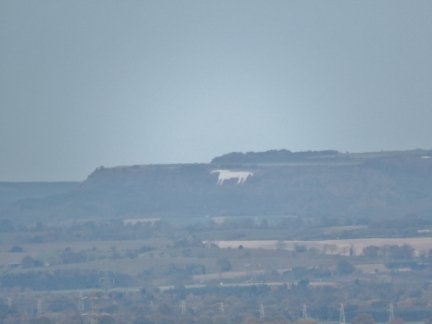 |
Kilburn White Horse
Position: -1 4.93, 53 57.74
The 318-ft (97 m) by 220 ft (67 m) Kilburn White Horse hill figure viewed from the York Minster central tower. The figure, cut into the hill in 1857, is believed to be the largest hill figure in England.
|
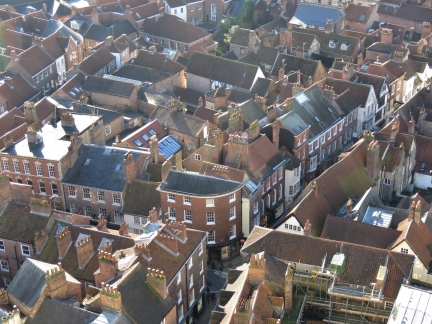 |
Houses
Position: -1 4.92, 53 57.73
Tightly-packed houses jam York’s narrow and winding streets.
|
 |
Drax Power
Position: -1 4.92, 53 57.73
The cooling towers of Drax coal power station, visible 20 miles away from York Minster. The station generates about 7-8% of the UK’s power.
|
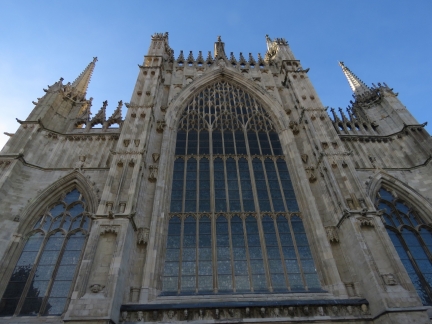 |
East Windows
Position: -1 4.86, 53 57.75
The Great East Window was completed in the early 1400s and contains the largest single expanse of medieval stained glass in the world, measuring 76ft (23.3m) high and 31ft (9.5m) wide.
|
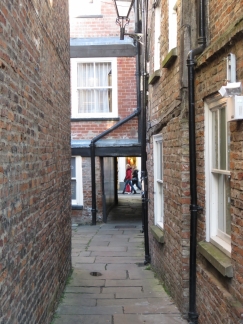 |
Lund’s Court
Position: -1 4.88, 53 57.63
Lund’s Court is one of many narrow alleyways between York’s twisting streets.
|
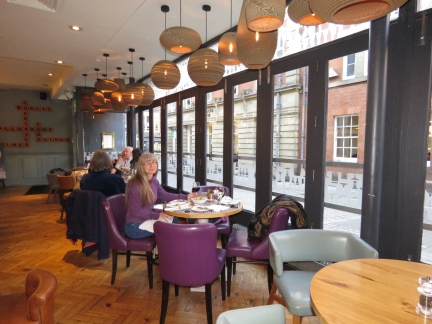 |
Lunch
Position: -1 5.03, 53 57.56
A late lunch with a street view at All Bar One on New Street in downtown York. Luckily, we picked the table that matched Jennifer’s sweater.
|
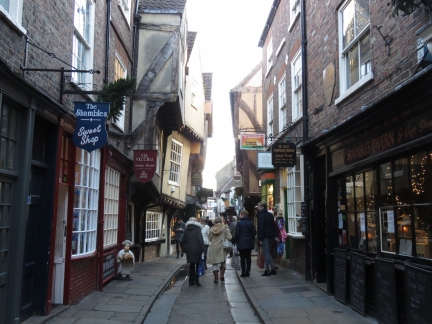 |
The Shambles
Position: -1 4.81, 53 57.59
The Shambles, with 15th century Tudor buildings overhanging the street, reminded us of the road where Harry Potter bought his school supplied in the Sorcerer’s Stone movie.
|
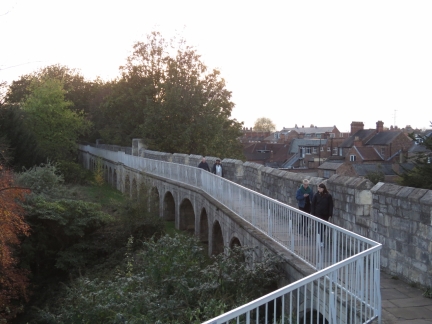 |
City Wall North Corner
Position: -1 4.88, 53 57.86
After lunch, we returned to the City Wall at the River Ouse to complete the circuit. These arches in the wall were created as part of a reconstruction in Victorian times. They wouldn’t have been particularly useful in a defensive wall.
|
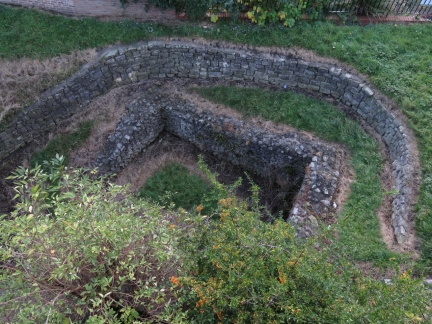 |
Roman Fortress
Position: -1 4.62, 53 57.72
The Romans founded York in AD 71 and built a fortress here. These are some of the ruins of that fortress, viewed from the York City Wall.
|
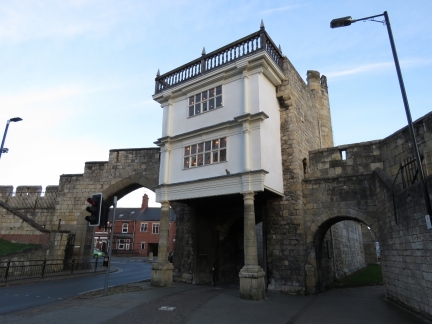 |
Walmgate Bar
Position: -1 4.26, 53 57.31
Several cafes are built into the wall. This one is at Walmgate Bar, one of the four main gatehouses through the original wall.
|
 |
River Foss
Position: -1 4.67, 53 57.27
Reflections in still water along York’s second waterway, the River Foss.
|
 |
Clifford’s Tower
Position: -1 4.81, 53 57.31
Clifford’s Tower, just inside the York City Wall, is one of the few obvious remnants of 13th-century York Castle.
|
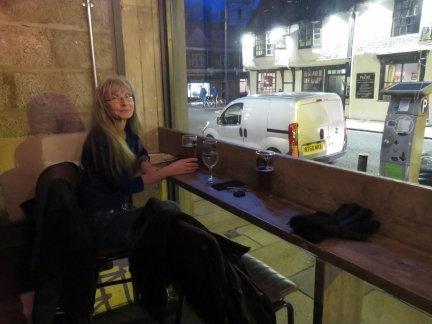 |
BrewDog
Position: -1 5.41, 53 57.38
After completing our circuit of the wall, we stopped off for a drink at BrewDog near Micklegate Bar. The street-side bar seat and the spartan setting reminded us of Unfiltered Brewing in Halifax, Canada.
|
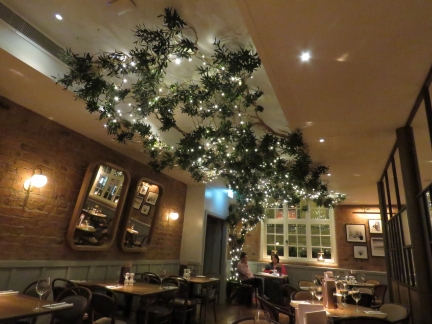 |
Dinner
Position: -1 5.00, 53 57.63
We finished the day at Gusto, with an excellent meal under their fabulous light-studded crawling vine.
|

|
Click the travel log icon on the left to see these locations on a map, with the complete log of our cruise.
On the map page, clicking on a camera or text icon will display a picture and/or log entry for that location, and clicking on the smaller icons along the route will display latitude, longitude and other navigation data for that location. And a live map of our current route and most recent log entries always is available at http://mvdirona.com/maps. |

So much history.
Amazing place.
Love the walls